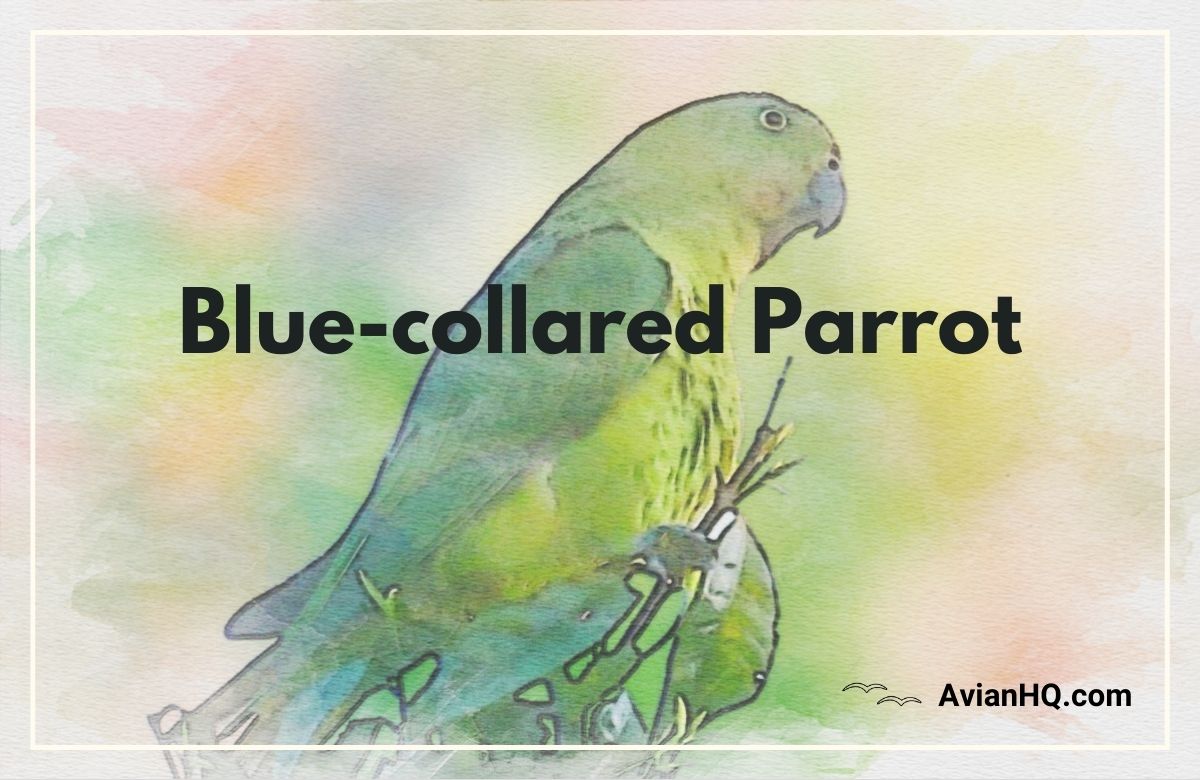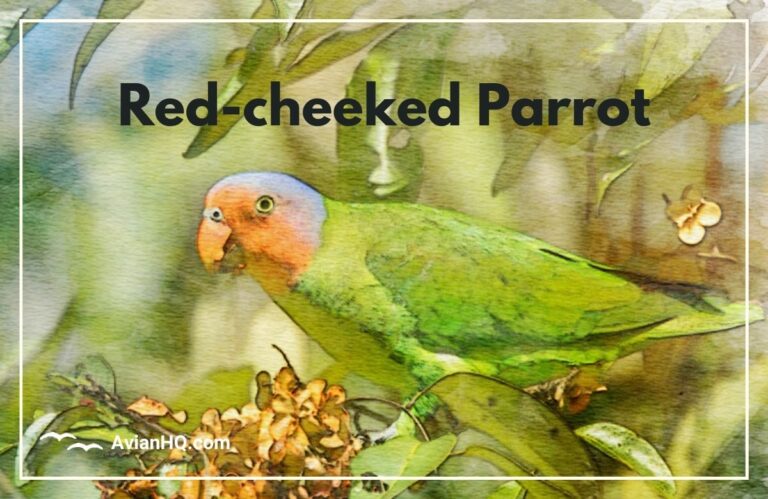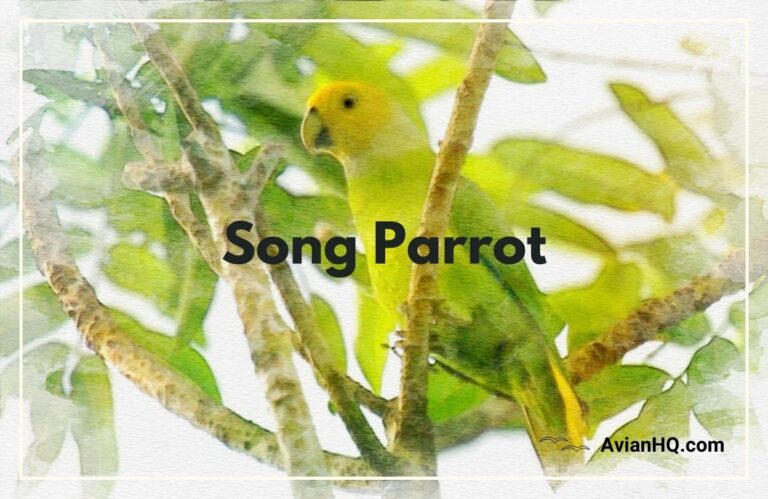Blue-collared Parrot (geoffroyus simplex)
As you wander through the dense montane forests of New Guinea, a flash of blue and green high up in the canopy catches your eye. You crane your neck upward and see a beautiful parrot perched on a branch – the Blue-collared Parrot.
This vibrant rainforest dweller is known by several other names, including the Simple Parrot, Lilac-collared Song Parrot, and Lilac-collared Geoffroy’s Parrot. Its scientific name is Geoffroyus simplex. No matter what you call it, the Blue-collared Parrot is a stunning sight.
In this guide, you’ll learn all about this little-known parrot species, including:
- Its natural history and discovery
- Physical appearance and subspecies
- Habitat and diet
- Breeding habits
- Conservation status
- Life in captivity as pets
So let’s take flight and soar into the treetops to get a closer look at the Blue-collared Parrot!
History
The Blue-collared Parrot was first scientifically described in 1874 by the zoologist Albert Bernard Meyer. He assigned the binomial name Pionias simplex to the species, classifying it within the genus Pionias.
In 1922, German ornithologist Ernst Hartert reclassified the parrot to the genus Geoffroyus, based on new taxonomic understanding. Hartert retained Meyer’s original species epithet simplex, which refers to the bird’s relatively plain coloration.
Two subspecies are recognized today:
- Geoffroyus simplex simplex – The nominate subspecies inhabiting the Vogelkop Peninsula of northwest New Guinea. Originally described by Meyer in 1874.
- Geoffroyus simplex buergersi – Named for zoologist Hans Bürgers in 1922 by Otto Neumann. Occurs central and southeast New Guinea.
The Blue-collared Parrot is endemic to the island of New Guinea. Its habitat range covers approximately 258,000 square miles (667,000 square km) across New Guinea’s central mountain forests. The species’ existence was likely known to indigenous peoples for centuries before its Western discovery in the 19th century.
Physical Appearance
The Blue-collared Parrot is a relatively small, stocky parrot, measuring about 8.5-10 inches (22-25 cm) long and weighing around 6.8-7 oz (195-200 g).
Its plumage is predominantly bright green. The forehead, cheeks, breast, abdomen, upper-tail coverts and undertail are all yellowish green. The upperparts and flight feathers are blackish green.
Several splashes of color stand out against the green. A bright yellow bend of the wing is visible in flight. The parrot has blue undertail and underwing coverts. The tail is green above and yellowish below.
The parrot’s eyes are a pale yellowish white. Its short bill is grayish black, as are its legs.
Sexual Dimorphism
Male and female Blue-collared Parrots are distinguished by differences in their blue plumage:
- Males have a distinctive sky blue band or “collar” stretching across the upper breast and lower neck.
- Females lack the collar entirely but may show some blue feathers on the rear crown.
Subspecies Differences
The two subspecies differ slightly in the extent of blue in their plumage:
- G. s. simplex males have a weaker, thinner blue collar.
- G. s. buergersi males have a broader collar that is more purple-blue in color. Their underwing coverts are also violet-blue.
Juvenile birds resemble adult females but have no blue feathers. Their bill is also paler than the blackish bill of adults.
Habitat
The Blue-collared Parrot inhabits the mountainous interior of New Guinea. Its elevational range stretches from approximately 1,640-7,550 feet (500-2,300 meters).
It is most frequently found at elevations between 2,625-6,235 feet (800-1,900 meters). However, parrots may wander to lower elevations, down to sea level, when searching for food.
This species mainly resides in humid hill forests and montane forests. It occupies both primary forest and secondary forest or regrowth.
Blue-collared Parrots are often seen along forest edges and clearings. They avoid open areas and agricultural land outside the forest.
Their range covers the higher elevations across much of New Guinea, including:
- Arfak and Tamrau Mountains on the Vogelkop Peninsula
- Central highlands and mountains of Western New Guinea
- Southeastern highlands of Papua New Guinea
The two subspecies occupy slightly different parts of this range:
- G. s. simplex – Vogelkop Peninsula
- G. s. buergersi – Central and southeast highlands
Diet
The Blue-collared Parrot is herbivorous and feeds on various plant materials high up in the forest canopy.
Its natural diet consists mainly of:
- Seeds and nuts from trees like oaks (Castanopsis, Lithocarpus)
- Berries
- Fruits
- Blossoms and nectar from flowering trees
The parrots use their strong beaks to crack open seeds and nuts. They likely swallow smaller seeds whole.
Blue-collared Parrots forage quietly while perched in trees. But they may gather in large, noisy flocks of up to 200 birds when flying together to feeding areas.
At times, they forage together with Red-cheeked Parrots, another New Guinea species. But Blue-collared Parrots also feed solitary, in pairs, or in small groups.
Reproduction
Relatively little is known about the breeding habits of Blue-collared Parrots. They nest in tree cavities, with breeding season likely occurring between October to January.
One nest was recorded at about 30 feet (9 meters) high in a tree stump. The nest hollow was approximately 3-16 inches (80-400 mm) deep.
The average clutch size appears to be 3 eggs. The eggs are incubated for about 3 weeks before hatching.
The chicks are fed and cared for by the parents in the nest for 6-8 weeks. They likely fledge at 8 weeks old.
More research is needed to better understand the breeding ecology and behaviors of wild Blue-collared Parrots in New Guinea. Their reproduction in captivity is also poorly documented.
Conservation Status
The Blue-collared Parrot is evaluated as Least Concern on the IUCN Red List of Threatened Species. Its global population size is unknown but likely numbers over 50,000 mature individuals based on its wide habitat range.
The species is described as generally rather rare to fairly common in the wild according to surveys. However, Blue-collared Parrots are shy and difficult to detect while perched in the forest canopy.
Forest loss is a potential threat, but there is no evidence yet of a significant population decline. As such, the IUCN currently considers the population trend stable.
Blue-collared Parrots are listed on Appendix II of CITES, restricting their international trade. Within New Guinea, they are not considered a major target of poaching or the cagebird trade compared to more popular species.
While not immediately threatened, continued habitat protection is needed across its montane forest range. Ecotourism may provide an incentive for New Guinea to conserve the species.
In Captivity
The Blue-collared Parrot is rarely kept in captivity. However, some experts and enthusiasts have succeeded in housing and breeding these shy forest birds.
Housing
These active parrots need a large aviary, preferably with shelter. A minimum dimensions of 8 x 3 x 7 feet (2.5 x 1 x 2 meters) is recommended. Provide multiple perches and enrichment.
Diet
In captivity, Blue-collared Parrots can be fed a varied diet including:
- Chopped fruits like banana, apple, orange
- Small bird seed mix with millet, oats, etc.
- Sprouted seeds
- Nectar powder
- Pollen
- Green vegetables
- Supplements
Breeding
There is limited information on breeding success in aviculture. However, Blue-collared Parrots are expected to behave similarly to other parrots in the genus Geoffroyus.
Offer nest boxes approximately 12 inches (30 cm) high x 4 inches (10 cm) wide with a 3 inch (8 cm) entrance hole. Line with soft wood shavings.
The female typically lays 3-4 eggs and incubates them for 23-24 days. Chicks fledge at 8 weeks old. Parent birds should be monitored and may need supplemental feeding.
With specialized care catering to their shy nature, Blue-collared Parrots can potentially thrive in captivity. But breeding remains challenging. Continued research is needed on their behavior and needs as aviary birds.
Conclusion
The Blue-collared Parrot is a colorful montane forest dweller endemic to the island of New Guinea. With its bright green plumage accented by a vibrant blue collar, this striking bird has captivated those fortunate enough to observe it in the wild.
While populations appear stable for now, the parrot merits continued monitoring and conservation. Ongoing protection of New Guinea’s dwindling mountain forests will be crucial to safeguard the Blue-collared Parrot’s arboreal habitat. Ecotourism and research can shed further light on the ecology and behaviors of this little-studied species.
Whether you glimpse a Blue-collared Parrot soaring over the canopy or admire one up-close in an aviary, you’ll be dazzled by its vivid hues. These birds embody New Guinea’s incredible biodiversity and the nature worth preserving across the “Land of the Unexpected”. If given the proper habitat, perhaps the Blue-collared Parrot will continue to flutter through New Guinea’s forests for centuries to come.





